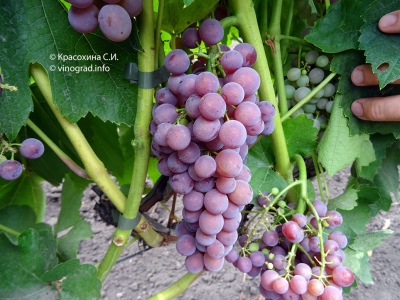
- Authors: New York State Agricultural Experiment Station, Cornell University, USA
- Appointment: universal
- Berry color: bright red with a slight waxy bloom
- Taste: specific, slightly strawberry
- With bones: No
- Ripening period: early
- Frost resistance, ° C: -27
- Bunch weight, g: 180-250
- Flower type: bisexual
- Density of the bunch: medium density
Grapes have been actively cultivated by amateur gardeners for a very long time. Every year, breeders work to develop new varieties. Scientists develop crops that are more adapted to climatic conditions, with improved and unusual tastes. One of them was the Ainset Sidlis variety.
Breeding history
Scientists from the United States worked on this type of grape at Cornell University, New York State Agricultural Experimental Station. To obtain Ainset Sidlis, the varieties Fredonia and Kanner were crossed (Hunitsa and Kishmish white oval).
Geography of distribution
The grapes are widespread not only in the southern regions, but also in cold regions.
Description
A bred hybrid grape variety for universal use. They use it both fresh and canned, and also make raisins from it, since the berries of this variety do not have seeds.
Spreading bush with high vigor. Shoots ripen 85-90%, which is ideal. By the end of the growing season, the vine acquires a brown tint, then darkens.
The size of the leaves is large, the edges are carved. Foliage color from green to dark green.
The grape has a bisexual flower type.
Ripening period
Ainset Sidlis was classified by the developers as an early variety. Ripening of berries occurs on the 110-115 vegetative day. The crop can be harvested from early August to mid-September. The ripening time depends on the growing conditions.
Bunches
The bright and beautiful conical bunches are of medium density. The weight ranges from 180 to 250 g. The clusters themselves are not very large, but there are many of them on the vine, because of this a good harvest is obtained.
Berries
Particular attention should be paid to the grapes. They are oval, medium-sized berries, weight of one from 2 to 3 grams, have no seeds. When fully ripe, the grapes become a bright red hue with a slight waxy coating. It is this plaque that protects the berries from cracking.
Taste
The taste of this variety is one of the main advantages. The pulp is fleshy-juicy, slightly slimy, has a unique original taste that resembles the taste of strawberries. The sugar content in grapes is from 190 to 210 g / dm3, acidity is in the range from 6.6 to 8 g / dm3. This justifies the bright and rich taste of the fruit.
Yield
Eicent Sidlis is distinguished by good yield. Although the brushes are not very large, there are many of them on the vine. Up to 45 kg of ripe fruits can be harvested from one bush.


Growing features
The grapes do not require special agrotechnical conditions.It is better to grow it on the south side, so that the clusters ripen at the same time. He does not like drafts, so it is better to choose a place for disembarkation that is closed from the winds.
Landing
Winegrowers plant this variety both as bushes and cuttings. First you need to prepare a landing pit. Its dimensions should be at least 80 cm in depth and approximately the same dimensions in width. You need to start preparing the pit in the fall. To do this, you need to fertilize the pit with compost or any mineral fertilizers, you can use well-rotted manure.
In the spring, the roots of the bushes are cut off a little, then they are placed in water for a day and only after that they are planted in a prepared hole. The planted material is covered with earth, lightly tamping it. Water the bushes sparingly so that the roots do not rot.

Pollination
As mentioned earlier, grapes of this variety have bisexual flowers, therefore, are capable of self-pollination. It is also pollinated by insects that are not averse to enjoying the nectar of this plant.
Pruning
Prune the vine in spring and autumn. In the spring, all dried, damaged processes are removed. In the fall, damaged or diseased stems are also harvested. 3-4 pronounced eyes are left on the vine. The total number of buds should not exceed 48-50.

Watering
Water the grapes sparingly. During periods of rainy, 2 times a month is enough, in dry times, watering should be increased up to 1 time per week. It is important that the plant is not flooded, otherwise the roots can get sick and begin to rot.


Frost resistance and the need for shelter
The frost resistance of the variety is very high. The plant tolerates frosts well down to -27 degrees. In regions where the temperature does not exceed this figure, shelter for the winter is not required.

Diseases and pests
The vine of this variety boasts a high resistance to diseases and pests. Resistance to diseases such as mildew and powdery mildew is equal to an indicator of 2 points. Winegrowers say that grapes generally do not get sick with some diseases - for example, bacterial cancer has never been seen in this culture. From pests, it is enough to spray the bushes in the spring.

If a grape is exposed to any disease or insect, this always affects its appearance.
Storage
The harvest is stored for a very long time - from 60 to 93 days, this allows transporting berries to other regions. Thanks to a light waxy bloom, the berries perfectly retain their presentation.











































































